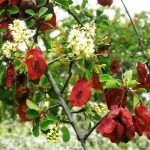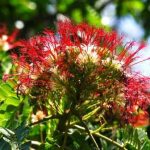TREE LIFE
March 2006
Please note that with immediate effect the post office box number for the Tree Society has changed to:
P.O. BOX A 273 AVONDALE HARARE
HARARE MASHONALAND CALENDAR
Tuesday 7th March: Botanic Garden Walk. Meet Tom in the car park at 4.45 for 5 pm. Tom will discuss the fig family – Moraceae.
Sunday 12th March: After the success of the previous “Show and Tell” evening there will be another one this month. If you have slides (any topic) or some computer pictures, or anything that would interest other members please bring them along. Once again it will be held at Adele’s house at No. 3 Normandy Close, Alex Park. Supper will be a bring and share arrangement. The idea is to bring along a few slides or computer images of general interest, or a specimen of any interesting or puzzling plants, or even a book. We will discuss your contributions or you may like to speak about them yourself. Adele has a slide projector and Mark a LCD projector. This should be a fun get together, and not too demanding on our precious fuel. Please bring something to eat and drink to share. Time 5.30 for 6pm.
Sunday 19th March: We are accepting Aldo and Alison’s offer of a return visit to their lovely property in the Arcturus area, this time in the middle of an exceptionally good rainy season, when the kopjie will be full of wonders.
Saturday 25th February: Mark’s Walk will be at 2.30pm. Please phone Mark for details of the venue.
MATABELELAND CALENDAR
Please contact Jean Wiley or Gill Short for details of the next Matabeleland function.
SUBSCRIPTIONS FOR 2006/7 Email Z$160,000 Printed copy: collected Z$320,000 Printed copy: posted Z$800,000
Once again, I must emphasise strongly that we do not want to lose members as a result of these increases. Each year a number of members pay more than the norm so that the excess goes anonymously to support members who may be having financial difficulties. So, please do not be proud; talk to Maureen, Terry or me. If paying by cheque, please make it out to CABS and on the reverse “Pay to the account of the Tree Society”
Mark Hyde
KUTSAGA: 15 JANUARY 2006
This was our second Tree Society outing to the tobacco research station at Kutsaga. The first was the ill-fated visit in June 2005, during one of the worst fuel shortages ever experienced in Zimbabwe, when only 3 members turned up; me and two others! However, this time, as most people have now more or less sorted out their fuel worries, the attendance was much better at 24 members. The number of people and the interest shown made me feel very positive about the Tree Society. Although overall numbers may be down, the attendance at our outings is still generally good. Kutsaga, in many ways, has been quite a useful discovery for the Society. Although much of the woodland is re-growth, the fact that the area is fenced off means that the bush is not under much pressure; there are plenty of trees, and the understorey and herbaceous layer are nice and relatively free of weeds. Add to that a dam, which increases the habitat richness, and good security and you have an ideal place for Tree Society outings. This time we assembled in miombo woodland near the little hut by the dam. After the persistent rains of this season, the bush was looking at its best. The soils are light and sandy and the altitude was 1470 m, so the flora was quite like the Mukuvisi Woodland or Cleveland Dam.
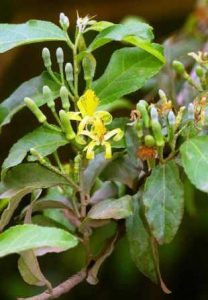
Grewia flavescens var. flavescens. Photo: Bart Wursten. Source: Flora of Zimbabwe
Here was Grewia flavescens var. flavescens. This is a scrambling shrub with long arching stems, sometimes almost a woody climber. Its most remarkable feature is its 4-angled stems; sometimes these are square in cross-section, at other times the flat sides are concave and the cross-section becomes almost cross-shaped. Although other grewia species have square stems, these are mostly rare, and especially around Harare, square stems almost always means flavescens. The important thing to remember when collecting a piece of a grewia for identification is to always look at the woody stems and remember whether they are angled or not. Another species in the woodland was Protea welwitschii. This generally fairly easily recognisable by its brown-hairy, narrow leaves (“welwitschii is welwitty” but there can be difficulties in separating it from P. gaguedi, which we saw later. Having got our eyes in on the common species, we set off along a path adjacent to the dam edge. Here was a damp grassland habitat with the bright yellow flowers and very rough leaves of Conyza welwitschii, a common species in and around Harare. There were also the minute yellow flowers of Hypericum lalandii.
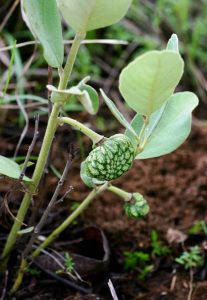
Annona stenophylla subsp. nana. Photo: Bart Wursten. Source: Flora of Zimbabwe
We stopped and examined Ozoroa insignis with its distinctive thick leaf texture and milky juice and also Annona stenophylla subsp. nana, the dwarf custard-apple which is frequent around Harare. Here too we came across a tall (1,5 2 m) Oenothera (evening primrose) with yellow flowers. This is a most unusual sight in Zimbabwe and as we were not far from a house at this point we looked for it in the garden, but there was no sign. Whatever species it is, it certainly seemed well naturalised. Pterocarpus rotundifolius (the Round-leaved bloodwood) is a common and quite distinctive species. Often a large tree, it has relatively few (c.5) large leaflets arranged alternately. It bursts into spectacular yellow flower in November/ December. At this point we reached the end of a finger of water from the dam and crossed a little stream before heading along the other side. Here was a young plant of Rauvolfia caffra, the Quinine tree. It was at Kutsaga that we saw it last June, but it is quite local around Harare where it is an occasional component of stream beds and riverine forest. It grows well in cultivation and is commonly planted by roads and in gardens around Harare. The leaves are arranged in whorls and have a milky latex. From this point we were slightly further away from the dam in open woodland with occasional termite mounds. Several very striking specimens of Pavetta gardeniifolia in flower were seen. This is a common shrub, a member of the Rubiaceae, which has black bacterial nodules in the leaves which can be seen when they are held up to the light. The flowers are white and are numerous in each inflorescence. Another tip for recognising this is that the leaves are strongly and unpleasantly foetid when crushed.
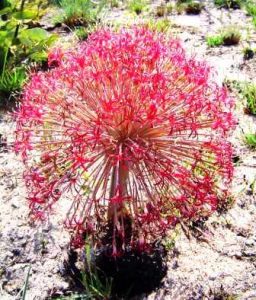
Boophone disticha. Photo: Bart Wursten. Source: Flora of Zimbabwe
Here also were the leaves of Boophone disticha, arranged in a fan. This species, known to many as Boophane, has recently had a name change and has become all “o”s. It is variously known in English as Tumbleweed, Veld fan and Windball, which sum up both what it does and what it looks like. A bit further on, we entered a more open grassy area with occasional shrubs; parts of it were a vlei with typical species such as the grass Eragrostis capensis; other parts were drier and more weedy.
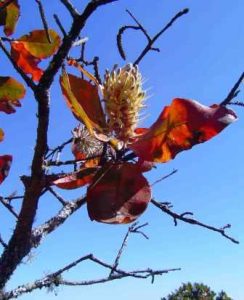
Faurea rochetiana. Photo: Bart Wursten. Source: Flora of Zimbabwe
Here were Faurea rochetiana (speciosa) and Dodonaea viscosa (the sand olive). At this point, rain was beginning to fall and lightning and thunder were evident, so we turned back, heading closer towards the dam. Amongst some rocks were fine specimens of Canthium lactescens. This is a shrub, also Rubiaceae, which often grows in rocky places. The remarkable feature, which we were able to demonstrate was that squeezing the terminal bud produces a thick viscous blob of milk. This is what gives the tree its specific name. As far as I know, this is the only Rubiaceae we have which produces milk in any shape or form. Further on were more species we had missed on the way out: Azanza garckeana, Vangueria infausta and Vitex payos. We returned to the little hut and ate our lunch. Incidentally, the dense colonies of fruiting orchids were apparently Eulophia nyassae another reason to return there, perhaps in the hot dry season or the early rains? In the afternoon, a slightly reduced party walked in the other direction. Here were some termite mounds and some additional species were added: e.g. Schotia brachypetala, Boscia salicifolia and Maerua triphylla. There was a very striking possibly escaped garden plant with pink spikes Stachytarpheta mutabilis. In all, an interesting day with a long list of species. Our thanks go to the authorities at Kutsaga for giving us permission to visit and to Terry for making the arrangements.
-Mark Hyde
OBITUARY Richard Barnes (1934 – 2004)
With the passing of Richard Delano Barnes the worlds of forestry, forest research and tree improvement lost a leading thinker and practitioner and I lost one of my oldest and best friends and colleagues. Richard died on 20th May 2004 at the beautiful home that he and his wife, Gillie, had created near Oxford. Richard was born in Bulawayo, Southern Rhodesia (now Zimbabwe) in 1934 of parents who owned and ran the Gwelo Times for many years. They lived on a small farm and much of his youth was spent in the saddle with a shotgun to hunt for the pot; later he exchanged the gun for the camera. His middle name, Delano, was shared with President Franklin Roosevelt but derived from a common ancestor, Philippe de la Noye of Luxembourg. Richard was educated at Chaplin High School in Gwelo and then studied forestry at Oxford in 1953, graduating with honours in 1957. He returned to his native land to take up a post for two years as Section Manager for 9000 hectares of pine and eucalypt plantations on Tilbury Estate owned by Border Timbers. In 1958 he then began a notable career of 20 years in the Rhodesian Forestry Commission. He started with a short period as Officer in Charge of Erin Forest Reserve but then became Working Plans Officer in the Research Branch for four years. He conducted surveys and produced full management plans for afforestation reserves, he prepared the management plan for the indigenous Rhodesian teak forests, and he initiated development plans for forestry in tribal trust lands. In 1962 Richard was appointed Officer in Charge of the John Meikle Forest Research Station and served under three Directors of the Forestry Commission, Max Hodgson, Bryan Armitage and Peter Banks, all of whom were highly supportive of tree improvement. This post was really the foundation of Richard’s later international reputation and impact. The Station, at Rupere north of Penhalonga and Umtali (now Mutare) in the Eastern Districts of Zimbabwe, must be one of the most beautiful locations in the world overlooking the high mountain border between Zimbabwe and Mozambique. It was chosen in the belief that tree breeding stations, and particularly seed orchard activities, needed to be located many miles from plantations and their potential pollen contamination. The total distance as the crow or pollen flies might have been five miles across a large mountain but the tortuous dirt road with its twenty-one hair-raising bends tested driving skills and added hugely to the distance; this limited the number of visitors from Head Office who might otherwise have distracted the important work in progress. It was at the Station in February 1965 that I first met Richard and Gillie who immediately showed my wife and me the hospitality for which they subsequently became so well known. Together they had created a fine home and office on the Station and they were accompanied in an adjacent house for many years by the Genetics Research Forester, Lyn Mullin; Richard and Lyn worked also with Dick Barrett, the Silvicultural Forester from the Research Branch and were the mainstays of practical silvicultural and tree improvement research programmes that became the envy of other African countries and indeed most countries elsewhere. From 1965 to 1969 I had the great privilege and pleasure of working with Richard as head of the Forest Genetics Research Laboratory of the Agricultural Research Council of Central Africa, providing basic information for the tree breeders in the countries Malawi, Zambia and Zimbabwe and beginning some degree of cooperation between them. We designed and published the results of many genetic experiments that became models for other countries and provided basic information for Richards’s own work. The tree improvement programme of the Rhodesian Forestry Commission included trials of many plantation species and provenances plus selective improvement of the four main pine species. These involved rigorous design and implementation of nursery and field experiments on a number of site types together with the development and application of selection, propagation and breeding techniques. The resultant improved material was widely planted in appropriate sites by the Forestry Commission and commercial companies while improved seed became a major earner of hard currency for the country (regrettably, latterly, little of it returning to forestry research). While working as Director of Research, Richard used part of his field work to complete an external doctoral programme in the University of London (1970 – 1973) based on extremely complex and immaculately implemented progeny trials of the Mexican species Pinus patula. Over a million items of growth, phenological and physiological data were included and this was only a small part of the total national programme that he established. In 1975 he was awarded the first Gold Medal of the Rhodesian Scientific Society for his contribution to scientific knowledge (in any field of science) within the last two years. With the declining situation in Zimbabwe, Richard and Gillie decided to transfer to the UK in 1977. He succeeded me as Senior Research Officer (Genetics) in the Unit of Tropical Silviculture at the Commonwealth Forestry Institute (later the Oxford Forestry Institute) in Oxford University. He continued and expanded the programme of research and provision of advice and information to all Commonwealth countries on their research and breeding programmes, particularly for industrial, commercial, plantation species, especially pines. Much of the work was financed by the British Government’s Overseas Development Administration (now the Department for International Development). In particular the series of international comparative and cooperative trials he established were models for the network research of several other research institutions and donor agencies. In all this work he was sympathetic to the problems of developing countries and devoted considerable time and effort to giving closer personal supervision and advice to a number of graduate research students from a range of countries. As global attention switched from commercial plantation forestry to social and community forestry, Richard changed the focus of his research from Central American pines to African hardwoods, principally the acacias. He became expert in the taxonomy, distribution, field ecology, phenology, variation and management of several indigenous species and initiated international seed collections and comparative species and provenance trials. Through continued ODA and DFID support and with collaboration from his Oxford colleagues, Chris Fagg, Dennis Filer and Stephen Harris, he was able to demonstrate the great value of these species in rural development and the importance of adaptive variability within them. Throughout his research career Richard Barnes showed a total dedication to meticulous research and scientific rigour coupled with high quality publication of results and their communication to peer scientists and to field practitioners. His OFI Tropical Forestry Papers are monuments to his work that will remain practically useful for decades. Some of his colleagues are striving to complete his magnum opus, a conspectus of the African acacias. Many of his journal articles were exemplary in their own scientific right and have also laid the foundation for theoretical understanding and breeding practice in many countries. He was a member of the advisory or editorial boards of Australian Forest Research, the Commonwealth Forestry Review and Silvae Genetica. He was chairman of the Rhodesian Branch of the South African Institute of Forestry in the 1970s and a member of the Governing Council and Executive Committee of the Commonwealth Forestry Association throughout the 1980s. He co-chaired the IUFRO Working Party on breeding tropical species from 1978 to 1986 during which time he organized major international conferences to place on record the great advances that were being made with and for developing countries. Among this heavy work load he was able to fit in several consultancies to governments and companies advising them on their own tree breeding strategies and programmes; he was an active member of GFASO’s Panel of Experts on Forest Genetic Resources for many years during the 1980-90s. Richard had huge energy and appetite for life; his prowess at show-jumping, rowing, tennis and squash was great and his later addiction to jogging legendary. He was prone to non-sporting but non-trivial accidents such as his encounters with snakes at home, sting-rays in Australia and canoe-biting hippopotamus on the Zambezi River. Perforce in Africa he had become expert at many life-saving skills and domestic trades but his furniture-making demonstrated his love for wood as a material. He was an outstanding photographer and many of his forestry and wildlife pictures are being prepared for a freely available compact disc with funding from DFID. He had a quiet, warm, self-effacing personality that did not seek personal aggrandisement, particularly unusual in the highly competitive atmosphere of a university such as Oxford. Richard never really enjoyed public speaking but gave excellent presentations of his work to conferences and visiting groups. He was always ready to give up time for visitors, students and colleagues, many of whom owe much of their own career success to his gentle support. He had a prodigious knowledge and appreciation of the natural ecosystems and the individual species of the many countries he visited and his love for Zimbabwe and its resources was apparent to all. He was infinitely saddened to watch from the UK the decline of his homeland under corrupt governance and, at a lesser scale, the decline of forestry and forestry-related research as academic disciplines within Oxford and other universities worldwide; his views of national and university politicians were equally scathing. Richard Barnes is survived by his wife, Gillie, their two children, Nicola and Philip, and Nicola’s four children, now living in Australia. The legacy of his work will outlive us all.
-Jeffery Burley
IN RETROSPECT Lyn Mullin DERIVATION OF SCIENTIFIC NAMES this ROOTNOTE, again from the able mind and pen of Kim Damstra, appeared in TREE LIFE No.50 (April 1984): It is often easier to remember a name if you know what it means, although often it means nothing of the sort. Swartzia madagascariensis, for example, is notable as it is widespread in Africa, but has never been found in Madagascar. If you thought your Latin was good enough to surmise that Tabernaemontana was named after some table-like mountain, think again. Tabernaemontanus, himself, was a botanical taxonomist! It also helps to know what the taxonomist was thinking of: abbreviata means shortened, which does not refer to the long pods of Cassia abbreviata, but possibly to the short racemes (bunches) of flowers. Kigelia is believed to originate from the native name kigelia-keia, and africana from Africa. The genus Markhamia is named after Sir Clements Markham (1830-1916), an English geographer and authority on the Inca civilization, whereas acuminata means sharply pointed at the tip, and obtusifolia refers to the obtuse angle of the foliage (leaves). [Comment 2000: According to DJ Mabberley’s The Plant-Book (1993), the genus Swartzia comprises 135 species, two from Africa and the rest from tropical America; some of them are cultivated ornamentally. Swartzia madagascariensis is our well-known snake bean. Tabernaemontana used to be known as Conopharyngia, and T. elegans is the toad tree. Markhamia acuminata (bean tree) is now named M. zanzibarica; this species and M. obtusifolia (golden bean tree) have very bright, showy, yellow flowers. In TREE LIFE No.65 (July 1985) we learnt a bit more about the taxonomist, Tabernaemontanus. Many early botanists preferred to identify with the Latin names they dealt out to plants, and altered their own names. The famous Linnaeus was really born Karl von Linn. Tabernaemontanus is the Latinized version of Jakolo Theodor von Bergzabern, personal physician to the Count of Palatine at Heidelberg, and the author of a famous herbal, Neuw Kreutebuch.
A ROOTNOTE from Kim Damstra in TREE LIFE No.51 (May 1984): For those interested in mathematics, plants provide some interesting facts in terms of phyllotaxis, or leaf arrangement. Take any branch that shows a spiral leaf arrangement, and trace a line from any given leaf to that leaf vertically above it, following the natural spiral of the branch. Count the number of times the spiral goes around the stem, and how many leaves are passed on the way (including one of the end leaves in the number). For example, in the yellowwood, Podocarpus latifolius, the spiral goes around the stem three times, and it is the eighth leaf that is directly above [the start-point leaf]. This can be expressed as the fraction 3/8. If a number of different plants are examined it will be discovered that only a limited number of these fractions exist in nature. They form an interesting series 2/5, 3/8, 5/13, 8/21… This series, in which each numerator (or denominator) is the sum of the two preceding numerators (or denominators), is known as a Fibonacci series. If these fractions are expressed as decimals they tend towards a limit of 0.38197. In practical terms this value can be translated into a fraction of a circle, 360 degrees, such that 0.38197 x 360 = 137 degrees 30 minutes 28 seconds. This is known as the ideal angle because, if the angle between two successive leaves is set at this, no two leaves would be directly above each other. A different set of Fibonacci numbers occurs in the cones of cycads and pines. If these are examined two sets of spirals will be seen – one set going clockwise around the cone, and the other anti-clockwise. One set of spirals is always steeper than the other, and also has more rows. If the number of spirals running one way and the other is expressed as a fraction, a new series of numbers emerges: 2/3, 3/5, 5/8, 8/13, 13/21… Most of the Encephalartos cones at the University have a 5/8 arrangement, although an 8/13 cone is also present. This series tends towards 0.61803. These fractions have been known for many years, and have fascinated successive generations because the two numbers have a distinct relationship: 0.38197 + 0.61803 = 1, and the ratio 0.38197 : 0.61803 = the ratio 0.61803 : 1. This latter ratio demonstrates the solution to an interesting mathematical problem: “to divide a line into two parts such that the relationship between the smaller and the greater is the same as the relationship between the larger part and the whole line”.
Wanted: articles for Tree Life
TREE LIFE NEEDS YOU or rather it needs your input. Articles, notes, comments, questions, observations all are welcome. Your contribution needn’t be long or weighty – a simple note or observation is often of great interest. Don’t be put off by thinking you don’t know enough. Sit down and pen something today!
MARK HYDE CHAIRMAN


